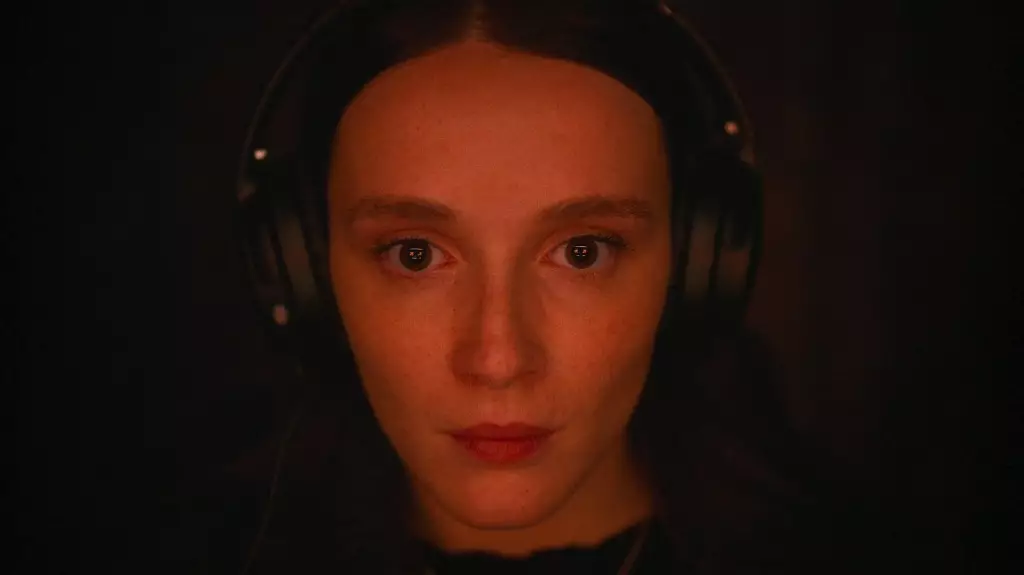Pascal Plante’s Red Rooms ventures into the unseen and the obscene, combining the overused genre of the serial killer movie with dark Lynchian surrealism to create something entirely fresh and original. This psychological horror film is not your typical courtroom drama; it delves into the depths of the human psyche. While Red Rooms may be unsettling for some, it is destined to achieve cult status and thrive on the genre circuit.
An Unfolding Plot
In Red Rooms, much of the plot has already taken place before the film begins. As the vivid crimson opening credits roll over Vincent Biron’s stark, steely blue cinematography, we witness Kelly-Anne (played by Juliette Gariépy) waking up and embarking on a bus ride to a sterile, tall building. Once inside, the film bursts to life with vibrant colors as Kelly-Anne passes through security and takes her seat in a bright, white, fluorescent-lit courtroom. The trial centers around Ludovic Chevalier (portrayed by Maxwell McCabe-Lokos), also known as The Demon of Rosemont, who stands accused of brutally murdering three young girls aged 13 to 16. What sets Chevalier apart is the heinous nature of his crimes – the victims were tortured before their deaths, all while a paying audience watched the horrors unfold live on the dark web.
The Battle in the Courtroom
The prosecution’s opening statement paints a chilling picture of the case, with Chevalier, confined to a Perspex case, watching emotionlessly from the sidelines. The trial hinges on two graphic half-hour videos, as the third video remains elusive. Chevalier’s defense team argues that he is a “model citizen” with a spotless record for all of his 39 years. They point out that there are no suspicious transactions in his bank account and no evidence of extravagant living. Despite the overwhelming circumstantial evidence, doubt lingers regarding Chevalier’s guilt.
An Unexpected Alliance
On her second day at the trial, Kelly-Anne encounters Clémentine (played by Laurie Babin), a murder enthusiast who has fallen for Chevalier. Clémentine believes the videos were fabricated and sees the trial as a mere spectacle. The two form an unlikely alliance, but their friendship’s power dynamics shift when the courtroom is closed for the viewing of the existing “snuff” videos. Kelly-Anne has already seen them and possesses them on a flash drive. Clémentine pleads to watch the videos, and witnessing their cruelty forces her to reevaluate her life choices and leave.
Kelly-Anne, however, continues to attend the trial. The question arises: why? This question, rather than the motivations of the deranged killer, lies at the heart of this darkly imaginative thriller. Throughout the first hour, it becomes apparent that something is amiss with the Chevalier case. Newspaper articles allude to a missing piece of the puzzle, and the elusive third video attains mythological status online. Could Kelly-Anne hold the key, and if so, is she complicit? The tension builds gradually, nearly becoming unbearable, until a nightmarish scene unfolds. Kelly-Anne emerges with freshly dyed blonde hair, blue contact lenses, and a school uniform identical to that of the third victim, bearing an uncanny resemblance. As the bailiffs remove her, Chevalier, previously impassive, looks up and waves. The motive behind these actions remains enigmatic.
Plante purposefully leaves the answer to this question elusive, instead layering the film with subtle nuances that provide glimpses into Kelly-Anne’s emotional state. Her career as a model suffers, and even the fetishist website Dream to Dare cancels a photoshoot due to rumors of her “extreme” interests, hinting at BDSM. Consequently, the movie can be interpreted as an S&M narrative, with Kelly-Anne somehow objectifying and consuming both the killer and the victim. This duality contradicts her kindness towards Clémentine, showcasing an unknowable capacity for depravity that she lives out in the realm of cyberspace.
Notably, Kelly-Anne’s online alias is Lady of Shalott, referencing Tennyson’s poem about a woman cursed to view the outside world solely through a mirror’s reflection. Kelly-Anne’s mirror is the dark web, and Gariépy’s chilling and captivating performance keeps audiences unnerved and unable to forget her presence throughout the film’s two-hour duration.

